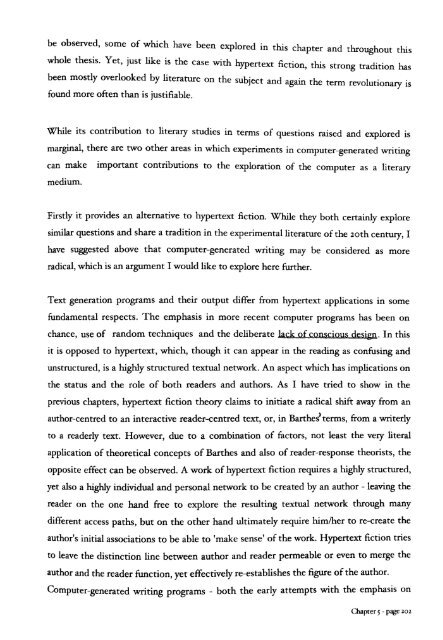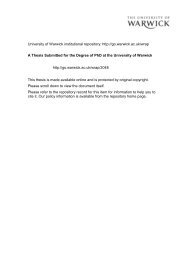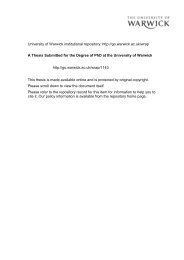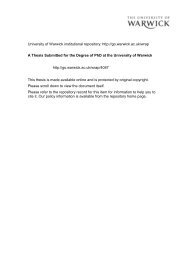From Page to Screen - WRAP: Warwick Research Archive Portal ...
From Page to Screen - WRAP: Warwick Research Archive Portal ...
From Page to Screen - WRAP: Warwick Research Archive Portal ...
Create successful ePaper yourself
Turn your PDF publications into a flip-book with our unique Google optimized e-Paper software.
e observed, some of which have been explored in this chapter and throughout this<br />
whole thesis. Yet, just like is the case with hypertext fiction thi t di ha<br />
, s s rong tra rtion s<br />
been mostly overlooked by literature on the subject and again th t I' ,<br />
e erm revo utionary IS<br />
found more often than is justifiable.<br />
While its contribution <strong>to</strong> literary studies in terms of questions raised and explored is<br />
marginal, there are two other areas in which experiments in computer-generated writing<br />
can make important contributions <strong>to</strong> the exploration of the computer as a literary<br />
medium.<br />
Firstly it provides an alternative <strong>to</strong> hypertext fiction. While they both certainly explore<br />
similar questions and share a tradition in the experimental literature ofthe zoth century, I<br />
have suggested above that computer-generated writing may be considered as more<br />
radical, which is an argument I would like <strong>to</strong> explore here further.<br />
Text generation programs and their output differ from hypertext applications in some<br />
fundamental respects. The emphasis in more recent computer programs has been on<br />
chance, use of random techniques and the deliberate lack of conscious design. In this<br />
it is opposed <strong>to</strong> hypertext, which, though it can appear in the reading as confusing and<br />
unstructured, is a highly structured textual network. An aspect which has implications on<br />
the status and the role of both readers and authors. As I have tried <strong>to</strong> show in the<br />
previous chapters, hypertext fiction theory claims <strong>to</strong> initiate a radical shift away from an<br />
author-centred <strong>to</strong> an interactive reader-centred text, or, in Barthes) terms, from a writerly<br />
<strong>to</strong> a readerly text. However, due <strong>to</strong> a combination of fac<strong>to</strong>rs, not least the very literal<br />
application of theoretical concepts of Barthes and also of reader-response theorists, the<br />
opposite effect can be observed. A work of hypertext fiction requires a highly structured,<br />
yet also a highly individual and personal network <strong>to</strong> be created by an author - leaving the<br />
reader on the one hand free <strong>to</strong> explore the resulting textual network through many<br />
different access paths, but on the other hand ultimately require him/her <strong>to</strong> re-create the<br />
author's initial associations <strong>to</strong> be able <strong>to</strong> 'make sense' of the work. Hypertext fiction tries<br />
<strong>to</strong> leave the distinction line between author and reader permeable or even <strong>to</strong> merge the<br />
author and the reader function, yet effectively re-establishes the figure ofthe author.<br />
Computer-generated writing programs - both the early attempts with the emphasis on<br />
Chapter 5 - page 202





